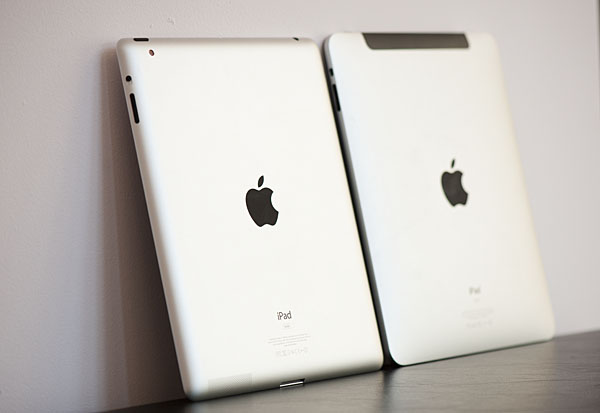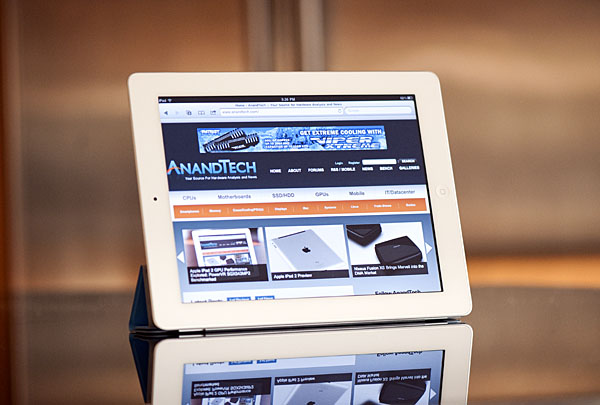The Apple iPad 2 Review
by Brian Klug, Anand Lal Shimpi & Vivek Gowri on March 19, 2011 8:01 PM ESTIndustrial Design & The Future
The original iPad was a device followed by so much hype and anticipation that inevitably, upon launch, it became one of the most polarizing products to launch in the last few years. It also became a huge hit, infusing life into the previously flatlining tablet market, and that's where the iPad 2 comes in.
The industrial design changes are very much in line with what we saw with the 4th generation Apple handhelds. The design language used for the iPhone 3G/3G-S and iPod touch 2G/3G was based on accelerating curvature continuity (known as G3 continuity in industrial design terminology), in contrast to the tangentially continuous design (G1 continuity) found on the original iPhone. What this meant, basically, is that the first iPhone had a relatively flat design, whereas the 3G/3G-S had a gently crowned back that aimed to fit the contour of one's hand.
The original iPad foretold the future of Apple's design language, using a similarly curved back but dumping the blended G3 curvature on the sides for hard edges that met the front face in a perpendicular manner. The iPhone 4 went a step further, with a flat back in addition to the sides. The front profile kept the same rounded corners that every other Apple device has, but the top and side cross-sections end up being rectangles, with all four faces meeting perpendicularly. I'm thinking Apple chose to do this to accomplish two things: being able to use glass for both the front and back faces, as well as to give the iPhone line some separation from the iPod and iPad lines.
The fourth generation iPod touch reaffirmed the notion that Apple was moving back to flatter, more rectangular designs. The use of aluminum instead of glass meant that there wasn't a need for a completely flat back; the predominantly flat back of the iPod tapers to meet the front face at the edges using a short continuous curve.
After seeing the newest iPod touch, I guessed that the second generation iPad would carry rather similar lines. I definitely didn't expect the iPad 2 to be so thin, but overall, it was pretty much in line with what I was expecting.
Another significant aspect to the industrial design changes is the addition of a white-bezeled iPad. The back of both black and white models are the usual anodized aluminum, though the texture of the anodizing on the iPad 2 (as well as the latest MacBook Pros) seems to be a different, smoother one than on previous aluminum Apple devices. Apple seemed to have moved to black bezels on almost all of its products, other than the vaporware-esque white iPhone 4, but between the iPad 2 shipping in white and a promised spring release for the white iPhone 4, it shows that Apple is trending back towards white devices.
The interesting question to ask here is how much we can read into Apple's future designs given the iPad 2, and unfortunately, that isn't a whole lot. It's always difficult to tell with Apple, but it wouldn't surprise me if the iPhone 5 ended up using a very similar design to the iPhone 4. Since the antenna problem is mostly solved (see the antenna diversity on the Verizon iPhone 4), Apple probably doesn't need to do a whole lot to the design for the next generation iPhone. Other than the signal attenuation issues, the iPhone 4 was an amazing piece of hardware, one that Apple spent a lot of money developing. It doesn't make sense for them to turn around and dump it on another ground-up redesign, especially when the 4 is still very competitive from a hardware standpoint. And at this point, I doubt they would focus so much on releasing the white iPhone in spring if they weren't planning on using a very similar chassis for the iPhone 5 that should launch in June.
Given past history, if the iPhone doesn't get a redesign, neither will the iPod touch. Both of the generation 5 handhelds will probably get some form of the A5 SoC, potentially underclocked like the A4 in the iPhone 4. What is more difficult to predict is the 3rd generation iPad. Since we don't really have an established cadence for the iPad, it's hard to say anything about the iPad 3 without reading too much into the iPad 2 launch. I'd say its safe to assume there will be a 6th generation Apple SoC (presumably named the A6), and if I was a betting man, my money would be on at least some form of redesign or at least an ID refresh, but again, with Apple, you really never know.













189 Comments
View All Comments
claytontullos - Saturday, March 19, 2011 - link
http://technabob.com/blog/2011/03/18/ipad-2-refrig... kind of fun?vol7ron - Saturday, March 19, 2011 - link
This just goes back to what I've said since the iPad was introduced. It'll be the +1 device that's best for laying around your house. This goes into my review as why it needs to hit the $200-250 price point.Sure it's a nice e-Reader and can entertain with some games and even allow for some production work, but it is still clunky and uncomfortable and to be efficient and productive you need the additional hardware, which are going to bring you in a nice laptop range anyhow.
The 3GS is hitting the $50-100 price point w/ a 2 year contract, which I suggested a year ago. Personally, I still think that should be the price w/o the contract (to be available after-market for gifts/presents), but as long it's available at that point, that's where it needs to be.
I still think the iPad needs to drop to that $200-250 point. It's the coffee table device, which people should consider having 2-3 spread-out in the home [ maybe one in the bathroom ;) ] - if only they could also self-sync wirelessly. I'm not too sure who buys the base model, but the specs alone would keep me from considering it and when you look at the higher spec'd models, it's not as justified when looking at laptops, or other eReaders.
solipsism - Sunday, March 20, 2011 - link
$200 to $250 for a newly released 10” Tablet with an IPS panel? WTF are you smoking? How can you have such an odd mental disconnect between writing that and then writing "The 3GS is hitting the $50-100 price point w/ a 2 year contract”? What part of 2-year contract aren’t you understanding? Do you not realize the carrier is paying Apple more than $200-250 for that 3GS, and you are paying the carrier a lot more than that over 2 years?Pray tell, how would this device be $200-250 when the competition with a 2 decade head start still hasn’t been able to compete on price?
synaesthetic - Sunday, March 20, 2011 - link
I don't get how they sell so many when they're so useless and clunky... and cost so much.Lot of hipsters I guess.
michael2k - Sunday, March 20, 2011 - link
The weight, battery life, and cost (altogether) are unparalleled in the computing world.Smartphones with similar performance characteristics have far smaller screens and lower battery life.
PCs with similar battery life cost far more and weigh far more.
PCs with similar weight (and still double at that) cost far more and have only fraction of the battery life.
PCs with similar cost weigh far more and have drastically lower battery life.
Meaker10 - Sunday, March 20, 2011 - link
A dual core sandy bridge 13" device is going to be far more useful for work and far more powerful.michael2k - Sunday, March 20, 2011 - link
Who said anything about work? For things like reading Anandtech it would be far heavier, bulkier, and with less battery life.bigboxes - Sunday, March 20, 2011 - link
Just admit that it's a toy. The authors laid it out for you on how they prefer to use other devices instead of the iPad. It too bulky for portability and underpowered for any productivity tasks.So, you're telling me (and everyone else here) that you paid $500+ just to surf AnandTech on your couch? Just wondering.
Stas - Monday, March 21, 2011 - link
That's exactly why it cannot cost this much to be a reasonable buy. No, the following purchases are not reasonable: fa- sheep base, soccer moms that buy the latest gadget with most hype for their kids/husbands not even knowing wtf it does, or PR boost in form of including, again, the most hyped device with cars, hotel rooms, air travel, etc (3 categories right there probably account for 90% of all sales). I mean people that understand exactly what the device is, what it's not, and have a clear idea of how they are going to use it. And it doesn't matter how much it costs to make it, how advanced the hardware is, or how "revolutionary" the design is. Given the limited usability of a slim, touchscreen device, I think asking $600+ for one is ballsy.MScrip - Monday, March 21, 2011 - link
-- "Given the limited usability of a slim, touchscreen device, I think asking $600+ for one is ballsy." --That's true about any tablet.
As great as Honeycomb tablets are... they're still not gonna provide a true computing experience.
A $600 laptop will always provide far more functionality than a $600 tablet...
Yet... all these manufacturers are pumping out tablets at an alarming rate.
Apple took the risk and added a new product to their lineup.
If tablets were destined to fail... we wouldn't see Motorola, Samsung and even RIM jumping into the tablet game...